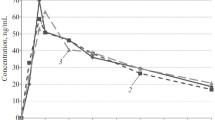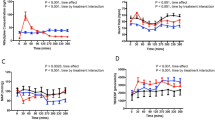Summary
The plasma concentration profile of oxprenolol after intravenous bolus injection, during intravenous infusion and following sustained oral administration was studied in a total of 106 patients with coronary heart disease. Speed of onset of pharmacodynamic activity, as measured by suppression of isoprenaline tachycardia, was discernible within a few seconds of central injection and complete within 5 min in all patients; variability in response was small. Following both i.v. bolus and intravenous infusion, plasma oxprenolol concentrations showed considerable between patient variability The plasma concentration/time profile observed in 16 patients following single intravenous oxprenolol bolus therapy was substantially higher, particularly during the early distribution phase, than observed and predicted volunteer data. Higher plasma oxprenolol concentrations were also attained during the more extended time sampling of the infusion studies; these findings would be compatible with reduced oxprenolol clearance in patients with ischaemic heart disease. During chronic oral therapy there was a many-fold between-subject variability in plasma concentration achieved following a given ingested dose. Correlation of antagonism of exercise tachycardia inhibition with plasma oxprenolol concentration in 15 male volunteers demonstrated near complete blockade of exercise stimulation of chronotropic beta-adrenoceptors at an average plasma oxprenolol concentration of 150 ng/ml. In coronary heart disease, such plasma concentrations can most conveniently be achieved by a 4 mg oxprenolol intravenous bolus with simultaneous infusion of 0.05 mg/kg/h; however, these studies provide sufficient information to allow alternative regimens to be derived should lesser plasma concentrations be considered desirable.
Similar content being viewed by others
References
Maroko PR, Kjekshus JK, Sobel BE, Watanabe T, Covell JW, Ross J Jr, Braunwald E (1971) Factors influencing infarct size following experimental coronary artery occlusion. Circulation 43: 67–82
Norris RM, Clarke ED, Sammel NL, Smith WM, Williams B (1978) Protective effect of propranolol in threatened myocardial infarction. Lancet 2: 907–909
Singh BN, Jewitt DE (1974) Beta-adrenergic receptor blocking drugs in cardiac arrhythmias. Drugs 7: 426–461
Taylor SH, Burley D (1977) Beta-adrenoceptor drugs in postmyocardial infarction dysrhythmias. Proc R Soc Med 70 [Suppl. 11]: 11–16
Prichard BNC, Aellig WH, Richardson GA (1970) The action of intravenous oxprenolol, practolol, propranolol and sotalol on acute exercise tolerance in angina pectoris; the effect on heart rate and the electrocardiogram. Postgrad Med J 46 [11 Suppl]: 77–83
Wilhelmsson C, Wilhelmsen L, Vedin JA, Tibblin G, Werko L (1974) Reduction of sudden deaths after myocardial infarction by treatment with alprenolol. Lancet 2: 1157–1160
Multicentre International Study (1977) Reduction in mortality after myocardial infarction with long-term beta-adrenoceptor blockade. Br Med J 2: 419–421
Norwegian Multicentre Study Group (1981) Timolol-induced reduction in mortality and reinfarction in patients surviving acute myocardial infarction. N Engl J Med 304: 801–807
Taylor SM, Silke B, Suttow GC, Prout B, Burley DM (1982) A long-term secondary prevention study with oxprenolol in coronary heart disease. N Engl J Med 307: 1293–1301
Diaz RG, Somber JC, Freeman E (1973) Withdrawal of propranolol and myocardial infarction. Lancet 1: 1068
Alderman EL, Coltart DJ, Wettach GE, Harrison DC (1974) Coronary artery syndromes after sudden propranolol withdrawal. Ann Intern Med 81: 625–627
Miller RR, Olson HG, Amsterdam EA, Mason DT (1975) Propranolol withdrawal rebound phenomenon: exacerbation of coronary events after abrupt cessation of antianginal therapy. N Engl J Med 293: 416–418
Yusuf S, Ramsdale D, Peto R, Furse L, Bennett D, Bray C, Sleight P (1980) Early intravenous atenolol treatment in suspected acute myocardial infarction. Lancet 2: 273–276
Hjalmarson A, Elmfeldt D, Herlitz J, Holmberg S, Malek I, Nyberg G, Ryden L, Swedberg K, Vedin A, Waagstein F, Waldenstom A, Waldenstrom J, Wedel H, Wilhelmsen L, Wilhelmsson C (1981) Effect on mortality of metoprolol in acute myocardial infarction. Lancet 2: 823–826
Kendall MJ, Mitchard M, West M, John VA, Ebbutt EF (1976) Factors influencing the absorption of oxprenolol — a pharmacokinetic study. Eur J Drug Metab Pharmacokinet 3: 155–160
Mason WD, Winer N (1976) Pharmacokinetics of oxprenolol in normal subjects. Clin Pharmacol Ther 20: 401–412
Jack DB, Reiss W (1974) Determination of low levels of oxprenolol in blood and plasma by gas liquid chromatography. J Chromatogr 88: 173–176
Metzler CM (1969) A users manual for Nonlin, Technical report 7292/69/7292/005. Upjohn Co., Kalamazoo, Michigan, USA
Gabaldi M, Perrier D (1975) In: Pharmacokinetics, Vol 1. Drugs and the pharmaceutical sciences. Marcel Dekker, New York, pp 69–80
White C de B, Udwadia BP (1975) Beta-adrenoceptor blockade and alpha-adrenergic potentiation. Br J Clin Pharmacol 2: 99–105
Jennings G, Bobik A, Korner P (1981) Influence of intrinsic sympathomimetic activity of beta-adrenoceptor blockers on the heart rate and blood pressure response to graded exercise. Br J Clin Pharmacol 12: 355–362
Reale A, Nigri A, Gioffre PA, Motolese M (1979) Acute influence of different beta-blocking agents upon left heart haemodynamics at rest and during exercise in patients with coronary heart disease. Eur J Cardiol 2: 101–109
Silke B, Hilal A, Taylor SH (1981) Haemodynamic dose-response effects of intravenous oxprenolol in coronary heart disease. J Cardiovasc Pharmacol 3: 716–727
Taylor SH, Silke B (1981) Haemodynamic effects of beta-blockade in ischaemic heart failure. Lancet 2: 835–837
Author information
Authors and Affiliations
Rights and permissions
About this article
Cite this article
Silke, B., John, V.A., Calvert, R.T. et al. Initiation and maintenance of beta-blockade with intravenous oxprenolol. Eur J Clin Pharmacol 24, 7–14 (1983). https://doi.org/10.1007/BF00613920
Received:
Revised:
Accepted:
Issue Date:
DOI: https://doi.org/10.1007/BF00613920




